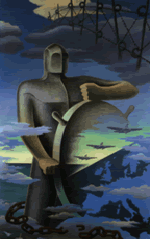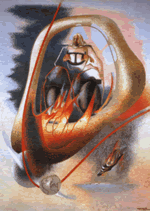This website uses cookies so that we can provide you with the best user experience possible. Cookie information is stored in your browser and performs functions such as recognising you when you return to our website and helping our team to understand which sections of the website you find most interesting and useful.
Fondazione Palazzo Ducale Genova
The main fascist iconographic motives interweave with the development of futurist research in the years straddling the two wars and in particular with the Thirties Manifesto of Aeropainting.
While the fascist political strategy used classical models in order to emphasize its similarities regime with the Roman Empire, the works of the artists who belonged to the various branches of the movement called Second Futurism still headed by Filippo Tommaso Marinetti reflect the celebratory themes of an official art inspired by war-mongering inclinations and a widespread cult of the Duce’s figure and personality. The painting by Ettore Thayaht, Il grande nocchiere (The Great Helmsman) 1939, which depicts Mussolini as a great robot, is a revealing example of this tendency.


